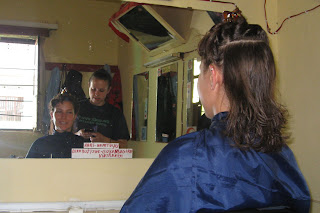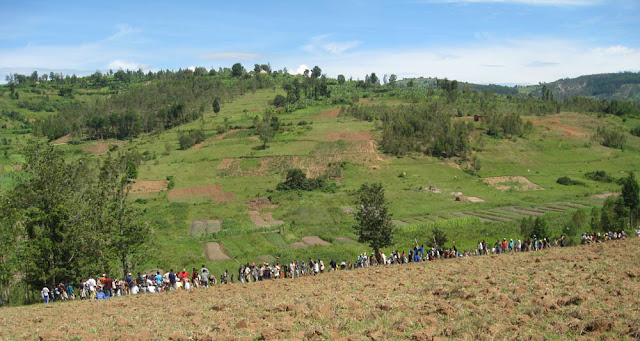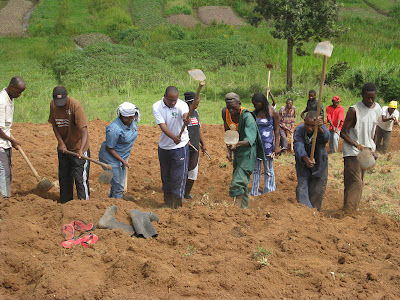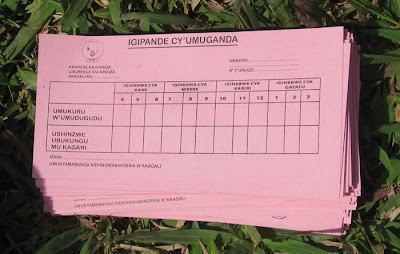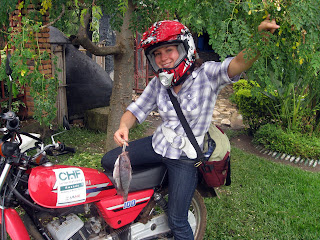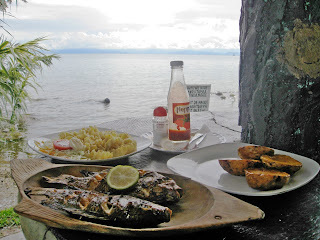I had an awesome birthday, thanks to my new friends here. Mup, the amazing training director, arranged for corn bread at snack time (called keke, it’s fantastic). I picked up my swearing-in dress from the tailor, who finally got it just right. Jenny cut my hair in her host family’s barber shop, which resulted in a hilarious video in which the barber next to us was shaving a poor customer’s head while looking at us. I’ll update this post with video when I have decent internet.
We cooked fantastic grilled cheese, fries and tomato soup. Her host family was incredulous about the soup with milk in it and cooked cheese sandwiches, so they also cooked beans and rice, but they seemed to like the American food. I certainly did.
Note: I'm labeling this post umunsi mukuru which means "holiday/day with a celebration" in Kinyarwanda.
Friday, April 30, 2010
Rwanda Links
- An article explores the debate over teaching about the genocide in Rwanda’s schools.
- Postcard Junky’s farewell to Rwanda is well worth reading. Sad to see him go.
- Rwanda makes the pages of Time, Reuters/Washington Post and the Wall Street Journal (via en24heures to avoid the paywall). Also, a flim about Rwanda premiered at the Tribeca film festival, attended by President Kagame.
- My Name Is Not Muzungu is a cogent new blog out of Kigali, a good read despite the author’s inability to spell in Kinyarwanda (Nitwa is one word, meaning “I am called,” while ni twa would mean “s/he is Twa,” Twa being Rwanda’s pygmy group).
- The New Times says that expat favorite Bourbon coffee shop has plans to open a shop in Boston?!!!
- Postcard Junky’s farewell to Rwanda is well worth reading. Sad to see him go.
- Rwanda makes the pages of Time, Reuters/Washington Post and the Wall Street Journal (via en24heures to avoid the paywall). Also, a flim about Rwanda premiered at the Tribeca film festival, attended by President Kagame.
- My Name Is Not Muzungu is a cogent new blog out of Kigali, a good read despite the author’s inability to spell in Kinyarwanda (Nitwa is one word, meaning “I am called,” while ni twa would mean “s/he is Twa,” Twa being Rwanda’s pygmy group).
- The New Times says that expat favorite Bourbon coffee shop has plans to open a shop in Boston?!!!
Thursday, April 29, 2010
Cross cultural hot dog issues
In honor of our last day of Kinyarwanda class, I present a lesson in cross cultural confusion. A few weeks ago, we were going over the imperfect tense by discussing what we used to do in America. The conversation inevitably turned to food.
“In America, I used to eat ice cream,” I said. My classmate said “In America, I used to eat hot dogs.”
Our teacher reacted with great surprise, which in America Rwandan means an explanation like “aaaaaay!”
“I know, some people find them gross, but I love them,” said my classmate.
“They eat them in the Congo, but Rwandans don’t do that, it’s wrong here,” said our teacher.
It was then that we realized he thought we were discussing eating actual dogs.
“In America, I used to eat ice cream,” I said. My classmate said “In America, I used to eat hot dogs.”
Our teacher reacted with great surprise, which in America Rwandan means an explanation like “aaaaaay!”
“I know, some people find them gross, but I love them,” said my classmate.
“They eat them in the Congo, but Rwandans don’t do that, it’s wrong here,” said our teacher.
It was then that we realized he thought we were discussing eating actual dogs.
Tuesday, April 27, 2010
Links
Rwanda links:
- The AP gave more western press attention to the volcano in my backyard. Last month park rangers finished clearing militias from Nyiragongo’s slopes, making it safe for tourists. The first thing on my to-do list after I finish Peace Corps and can go to Congo without losing my job: climbing Nyiragongo.
Sprawling across the floor of the volcano's steaming cone, the lava lake resembles a colossal pie crust, its blackened surface riddled with fiery red zigzagging fissures where magma is blazing through. Its power is evident in the nonstop roar accompanying it, a soundtrack akin to the perpetual rumble of a gargantuan waterfall.
The lake surface is in constant motion, shifting slowly, splitting, sinking, consuming itself, spewing lava in prodigious gurgling fountains — a real-life Hades that's hard to turn away from.
…. There are no guard rails at the summit.
- An article about gender based violence in Rwanda and the joint government/UN response.
- Rwanda’s 10-year tourism plan identifies Gisenyi as one of 7 priority destinations for development.
General links:
- Hand Relief delivers some of the best development satire ever.
- As a U2 fan in the development field, Bono’s New York Times columns usually embarrass me, but his latest was pretty good and contained relatively few “Africa is a country” allusions:
- Howard French’s work on Africa is always interesting; this month he has a long but worthwhile article on China and Africa in The Atlantic. Its bottom line is, China is developing an extractive relationship, masquerading as a partnership, that is likely to enrich China while failing to contribute to meaningful or lasting development for Africans.
Sunday, April 25, 2010
Outfits of Umuganda
Umuganda presented an opportunity to photograph some of the clothing that makes its way from the West to second-hand shoppers in Rwanda. Here are some gems:
Above left, this guy laughed at me for not hoeing well, but he had figure skates on his sweatshirt.
Above right, Harry Potter would have had the hoe going on its own with a few simple incantations. But I’d put a lot of money on this guy never having read or seen Harry Potter.
I’m jealous of this sweet Ferrari shirt, below left as he cuts up cassava branches...
Above right, I wonder if the ladies in Norfolk appreciate the fantastic workout that comes from hoeing – great for your upper back and arms!
Labels:
fashion,
globalization,
markets,
umuganda,
unintentional comedy
Saturday, April 24, 2010
Umuganda
Today was the last Saturday in April, so many of us trainees headed back to the field we helped hoe last month. This time I brought my camera.
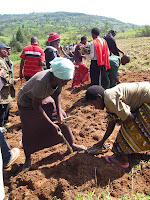 Today’s activity was turning the soil again to break it up, and then planting cassava. Sticks from cassava plants were delivered by truck from Kigali, broken up into 6-8 inch pieces with sprouts, or “eyes,” and partially buried in the dirt with the eyes pointing up towards the sun.
Today’s activity was turning the soil again to break it up, and then planting cassava. Sticks from cassava plants were delivered by truck from Kigali, broken up into 6-8 inch pieces with sprouts, or “eyes,” and partially buried in the dirt with the eyes pointing up towards the sun.When the cassava is grown, it will either be distributed to the poor or sold to raise money for a project in the local area.
I was very impressed that both the Mayor of Nyanza district and the Governor of the entire Southern Province turned out to help. The governor was hard at work but was kind enough to let me take his picture. He is below, with a hoe overhead. (He’s very sporting in an outfit of a Nike hat, Fila shirt, and Adidas pants; Reebock should endorse him as well.)
The Mayor is above, roughly center in the white polo shirt, pioneering an interesting hoeing technique. He’s a helpful and friendly man who has made us very welcome in Nyanza.
After a few hours of work, the crowd gathered to hear the Mayor and Governor speak about the organization of the August elections.
Those who participate in Umuganda get pink record cards with space for their village and cell officials to endorse their attendance. As you can see, this card begins in April (the 4th month) and has space for a year. I am told that if a person is involved in a local dispute they may present their Umuganda participation card to demonstrate their credibility as a good citizen. In some parts of Rwanda, failure to contribute to Umuganda may incur a fine.
Friday, April 23, 2010
Sports Scavenger Hunt Update
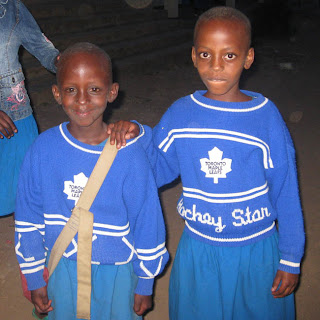 One of the common school uniforms around here consists of a blue dress and blue sweater. These two blue sweaters caught my eye, as they are the first evidence of the NHL I’ve seen in Rwanda. New teams in bold.
One of the common school uniforms around here consists of a blue dress and blue sweater. These two blue sweaters caught my eye, as they are the first evidence of the NHL I’ve seen in Rwanda. New teams in bold.Baseball tshirts: red sox, angels, Yankees, cardinals, pirates, diamondbacks, marlins
Nba: kings, Celtics, bulls
NFL: eagles, patriots
NHL: maple leaves
Thursday, April 22, 2010
More on Gatagara Pottery

 Last week I returned to Gatagara Pottery as part of training, first to conduct a needs assessment and then to do a presentation.
Last week I returned to Gatagara Pottery as part of training, first to conduct a needs assessment and then to do a presentation. The Pottery cooperative was originally founded in the 1970s when European ceramists helped set it up using local materials, fusing modern ceramic technology and traditional pottery methods of the Twa. Before 1994, the cooperative supported up to thirty families, but lost some twenty members during the genocide. In 1997 a European charity helped the Pottery restart. Today they have ten members who receive a monthly salary. All are male (they expressed the belief that previously women were not considered strong enough for their work, but today they would be welcome). Their main challenge is finding customers: some weeks they receive none or one customers in Gatagara, and their only other markets are one shop in Kigali and one hotel in Nyungwe. One or two times a month they receive orders for products.
Nearly all the materials are found within 1-15 kilometers from Gatagara: Clay, kaolin, bricks for the kiln, and materials for the glazes including feldspar, talc, iron oxide, and ashes of eucalyptus, straw and hay. Only sieves and a few components of the glazes are imported from Belgium. They can store the clay for up to several years. They throw on both manual and electric wheels, do an initial bisque firing at 950-1000 degrees Celcius, then glaze the ceramics and fire them again at 1300 degrees.
Their work is very high quality, but their self-promotion has been limited. In our presentation, we spoke to them about techniques they could use to market themselves. We recommended that they improve their bare-bones sign on the main road to advertise a demonstration and gift shop. We also provided them with contact information for various hotels and tourism agencies, and demonstrated a phone call with a hotel to ask about sending visitors to the Pottery or selling their products. Although we had to overcome a few communication issues, hopefully our advice was useful to the cooperative.
Sunday, April 18, 2010
Cooking fish! (with recipe)
Fresh fish in the market meant a last minute menu change for “Cooking with Muzungus” today. I learned how to gut and scale fish and to make a peanut broth for the fish and ubugari, and I present it here as my first Rwandan recipe.
Ingredients (amounts are my estimates, feel free to adjust):
Fish (ours were whole with bones, 2 per person, so I leave the specifics up to you)
1.5 medium red onions, sliced
1 green pepper, sliced
1 stick celery, diced (use leaves, too)
Tomatoes, peeled and cut up (1 can diced tomatoes would work)
Peanut powder (Peanut butter would work) – a lot, to taste
Water for broth
Oil (a bit more than you’d normally use is probably the right amount)
“fish masala” (cumin, coriander, tumeric, msg)
Red beans (Kidney beans?) – one can would do
Note that flavor will be enhanced by cooking over charcoal.
Cook the fish (we lightly powdered them with cassava flour and deep fried them in oil but you may choose a healthier and more headless method) and set aside (covered, to keep flies off).
Saute 1 onion with the pepper and celery. If you fried the fish, use the same oil for this. Add the tomatoes and cook a few minutes more. Add seasoning, water and peanut powder, cook until flavors are blended. Add fish and heat through.
While heating, saute ½ an onion in oil and add beans. Cook for 5-10 minutes to develop flavor.
Serve with Ubugari or over rice. Add beans as desired to individual bowls.
Saturday, April 17, 2010
Friday, April 16, 2010
Rwanda links
- I dislike Kristof, but this is a guest post on Rwanda’s rapid development over the last 5 years. I'm certainly in the so-called "posh corps," which means that thanks to Rwanda's great progress I'll have running water and electricity (most of the time). The column discusses the progress and challenges towards meeting "Vision 2020" to make Rwanda middle income by the end of the decade.
- Related, the BBC did a video on supermarket shopping in Kigali. This and the other Rwanda videos linked on the page are probably worth a look, but I can’t access them with this internet connection.
- The opening paragraphs might feed too much into the “Africa is the land of rape and lions” trope, but the Globe and Mail published an interesting article on why Goma is the most dangerous city in the world (hint: the active volcanos). Goma lies just over the border from Gisenyi, but...at least border security is good. Though I’m not sure border security is a match for lava, so keep your fingers crossed that Nyiragongo remains a nifty red glow in the nighttime sky.
- Congo Siasa sometimes covers Rwanda.
- I'm thankful Rwanda's cell network is better than Congo's.
- A photo gallery of Hutus who helped save Tutsis during the 1994 genocide. I can't properly load it, but you probably can. It's very important to recognize these heroes.
- The story of how a Rwandan football player's life was spared because of his fame. The role of sports in this world we live in is pretty ridiculous.
- If this new Kinyarwanda-English dictionary is actually well-organized and comprehensive, nishimiye cyane! (I'm very happy!)
- Related, the BBC did a video on supermarket shopping in Kigali. This and the other Rwanda videos linked on the page are probably worth a look, but I can’t access them with this internet connection.
- The opening paragraphs might feed too much into the “Africa is the land of rape and lions” trope, but the Globe and Mail published an interesting article on why Goma is the most dangerous city in the world (hint: the active volcanos). Goma lies just over the border from Gisenyi, but...at least border security is good. Though I’m not sure border security is a match for lava, so keep your fingers crossed that Nyiragongo remains a nifty red glow in the nighttime sky.
- Congo Siasa sometimes covers Rwanda.
- I'm thankful Rwanda's cell network is better than Congo's.
- A photo gallery of Hutus who helped save Tutsis during the 1994 genocide. I can't properly load it, but you probably can. It's very important to recognize these heroes.
- The story of how a Rwandan football player's life was spared because of his fame. The role of sports in this world we live in is pretty ridiculous.
- If this new Kinyarwanda-English dictionary is actually well-organized and comprehensive, nishimiye cyane! (I'm very happy!)
Obama in Rwanda
Yes, that's Obama "with his Vice Joe Bidden" (an interesting take on their relationship) and Obama's convoy to "Chicago" where the flags look suspiciously British. A closeup from a larger Obama-loving poster.
Thursday, April 15, 2010
X-rated Kinyarwanda mistake of the day
The story goes that there was a European priest who was learning Kinyarwanda, as any good foreign missionary will do. One day he had a meeting with a man who worked in an office, so he walked in and addressed the secretary, a young and modest Muslim woman. “I’m looking for the man who likes books,” ibitabo, he said. Or tried to say. But what he actually said was “I’m looking for the man who likes ibituba,” or “the man who likes vaginas.”
Sunday, April 11, 2010
Iron chef Rwanda
Task: feed twelve people.
Challenge one: shopping in the market in only thirty minutes. Because of genocide week, the market closed shortly after we finished lunch. I rushed down with Zilpa and Assinath, two wonderful trainers who live in my house, and we rushed around. Zilpa bought sweet potatoes and oil. Assinath and I bought beans and veggies before we split up: she went to find our a leafy green, little eggplant, and peanut powder, while I grabbed as much fruit as I could for desert. I ended up frantically haggling with two women as they packed up their fruit, trying not to pay the muzungu price. Still arguing, we were pushed out by the police, and settled up outside the market walls. The frantic shopping amidst the bustle of the closing market was exhilarating. All told, I didn’t do too badly: I was shorted on the passion fruit and tree tomatoes, but including the cheese and corn bread I bought earlier, the entire meal cost about $17 for 12 people.
Challenge two: cooking 3 dishes on two charcoal stoves. We (er, Assinath) immediately lit one stove and started the dried beans cooking. With help from some of our house mates and dinner guests, we peeled and sliced several kilos of knobby white sweet potatoes, which Zilpa then spent hours double-frying on the second charcoal stove. I soaked the fruit in bleach-water to make it safe to eat. We chopped the eggplant, peppers, carrots, tomatoes, celery, onion, garlic (sold pre-peeled in the market, awesome), and urusenda chili pepper for our “American beans,” or chili. We washed the renga-renga greens and shredded them (Assinath with just a knife, me with kitchen scissors). When the beans were cooked, I fried the veggies and urusenda with some Indian-style “chicken masala” (clove, cumin, coriander, tumeric, etc) and then added the beans. Finally, we watched as Assinath prepared the greens with toasted peanut powder, a recipe I’ll share later.
The meal was a great hit, and our three trainers as well as our night guard loved “American beans.” Our desert was a heavenly fruit salad of mango, pineapple, passion fruit, tree tomato, and banana. Everybody ate too much, and we still had leftovers.
Challenge one: shopping in the market in only thirty minutes. Because of genocide week, the market closed shortly after we finished lunch. I rushed down with Zilpa and Assinath, two wonderful trainers who live in my house, and we rushed around. Zilpa bought sweet potatoes and oil. Assinath and I bought beans and veggies before we split up: she went to find our a leafy green, little eggplant, and peanut powder, while I grabbed as much fruit as I could for desert. I ended up frantically haggling with two women as they packed up their fruit, trying not to pay the muzungu price. Still arguing, we were pushed out by the police, and settled up outside the market walls. The frantic shopping amidst the bustle of the closing market was exhilarating. All told, I didn’t do too badly: I was shorted on the passion fruit and tree tomatoes, but including the cheese and corn bread I bought earlier, the entire meal cost about $17 for 12 people.
Challenge two: cooking 3 dishes on two charcoal stoves. We (er, Assinath) immediately lit one stove and started the dried beans cooking. With help from some of our house mates and dinner guests, we peeled and sliced several kilos of knobby white sweet potatoes, which Zilpa then spent hours double-frying on the second charcoal stove. I soaked the fruit in bleach-water to make it safe to eat. We chopped the eggplant, peppers, carrots, tomatoes, celery, onion, garlic (sold pre-peeled in the market, awesome), and urusenda chili pepper for our “American beans,” or chili. We washed the renga-renga greens and shredded them (Assinath with just a knife, me with kitchen scissors). When the beans were cooked, I fried the veggies and urusenda with some Indian-style “chicken masala” (clove, cumin, coriander, tumeric, etc) and then added the beans. Finally, we watched as Assinath prepared the greens with toasted peanut powder, a recipe I’ll share later.
The meal was a great hit, and our three trainers as well as our night guard loved “American beans.” Our desert was a heavenly fruit salad of mango, pineapple, passion fruit, tree tomato, and banana. Everybody ate too much, and we still had leftovers.
Friday, April 9, 2010
Wednesday, April 7, 2010
Memorial week
Today Rwanda marked the 16th anniversary of the beginning of the genocide. It was intense. During breakfast, an eerily low fog blew through town, first making the valley behind the center look washed out and then blocking our view of the cell tower just 50 meters away. As we walked through Nyanza the sun burned through the fog and the day grew very hot.
We joined a group marching towards the stadium; many wearing royal purple kerchiefs as a symbol of mourning. Next to the stadium is a mass grave. Perhaps hundreds of these can be found in Rwanda: a compound surrounded by a wall, bearing some sort of monument or marker, in which anonymous bodies of genocide victims are buried. Nyanza district had one of the highest death tolls in the country, and this particular mass grave contains 40,000 bodies, which took two years to bury.
We stood in a crowd of several thousand stood in the outside the mass grave, listening to a speech I did not understand. Rwandans, we have been told, do not cry, and certainly not in public. Today was different. One woman began to wail, and was lead away from the crowd by another. We then made our way to the stadium and were seated in the stands, which stretch across the east side of the field. For several hours, local speakers alternated with mournful music, and finally they closed with the radio broadcast of the president’s speech in English and Kinyarwanda.
When the music was playing, some women broke down and were led or carried away from the crowd to privacy across the field or behind the stands. It wasn’t always clear that they wanted to move, but they were removed from the stands. You could see that some were clearly having flashbacks: one woman ran from the stands carrying a baby, pursued by several well-intentioned people who wrestled the baby from her hands as she screamed. They did this to protect them, but the scene was reminiscent of so many that must have played out 16 years ago. It was incredibly hard to sit there and hear people’s grief, to not cry myself, but I felt like I had no right to cry. Many others in the stands cried a few silent tears or wiped their noses while no tears fell.
While there were 5 men around the stadium wearing Red Cross jerseys, I was struck by how inadequate the mental health services were today. People were retraumatized, or were overwhelmed with grief, and they were carried away from the crowd whether they wanted to be or not. I’m not a mental health professional, so I only can say that more mental health services are needed here.
For one week, Rwanda will observe memorial week. Businesses will close in the afternoon and there will be various lectures and events. The week will close, as always, on the 13th, with a commemoration of the politicians who were killed due to their opposition to the genocide. This year’s memorial week honors those whose bodies ended up in the water or were otherwise not given a proper burial.
We joined a group marching towards the stadium; many wearing royal purple kerchiefs as a symbol of mourning. Next to the stadium is a mass grave. Perhaps hundreds of these can be found in Rwanda: a compound surrounded by a wall, bearing some sort of monument or marker, in which anonymous bodies of genocide victims are buried. Nyanza district had one of the highest death tolls in the country, and this particular mass grave contains 40,000 bodies, which took two years to bury.
We stood in a crowd of several thousand stood in the outside the mass grave, listening to a speech I did not understand. Rwandans, we have been told, do not cry, and certainly not in public. Today was different. One woman began to wail, and was lead away from the crowd by another. We then made our way to the stadium and were seated in the stands, which stretch across the east side of the field. For several hours, local speakers alternated with mournful music, and finally they closed with the radio broadcast of the president’s speech in English and Kinyarwanda.
When the music was playing, some women broke down and were led or carried away from the crowd to privacy across the field or behind the stands. It wasn’t always clear that they wanted to move, but they were removed from the stands. You could see that some were clearly having flashbacks: one woman ran from the stands carrying a baby, pursued by several well-intentioned people who wrestled the baby from her hands as she screamed. They did this to protect them, but the scene was reminiscent of so many that must have played out 16 years ago. It was incredibly hard to sit there and hear people’s grief, to not cry myself, but I felt like I had no right to cry. Many others in the stands cried a few silent tears or wiped their noses while no tears fell.
While there were 5 men around the stadium wearing Red Cross jerseys, I was struck by how inadequate the mental health services were today. People were retraumatized, or were overwhelmed with grief, and they were carried away from the crowd whether they wanted to be or not. I’m not a mental health professional, so I only can say that more mental health services are needed here.
For one week, Rwanda will observe memorial week. Businesses will close in the afternoon and there will be various lectures and events. The week will close, as always, on the 13th, with a commemoration of the politicians who were killed due to their opposition to the genocide. This year’s memorial week honors those whose bodies ended up in the water or were otherwise not given a proper burial.
Tuesday, April 6, 2010
Fresh fish!
Last Thursday my counterpart, B., and I visited a few of the cooperatives I’ll be working with (more in a future post). We were in beautiful Nyamyumba, the sector to the south east of Gisenyi on Kivu, home to Rwanda’s beer factory and some incredible views of the lake and the clouds over the Congo.
We motoed up to a lake-side bar and B. asked about their menu. Next thing I knew, we were hopping back on the moto to travel 100 yards down the road where fishermen (abarobyi, “Ah-bah-robe-gee”) were bringing in their catch. After the requisite haggling (“the muzungu doesn’t have money”) we got 2 fish, which the woman promptly scaled, gutted, and strung up so I could dangle them off the side of the moto as B. drove us back to the restaurant.
(Please take a moment to laugh at my ridiculous Peace-Corps-issued moto helmet and the flattering chipmunk effect it produces. At least I was able to trade in the one with pink butterflies on it.)
Some time later, we were served the freshest fish I’ve ever tasted, perfect with a little lime and a side of fried potatoes.
A few other photos from my site visit are up on my Picasa.
We motoed up to a lake-side bar and B. asked about their menu. Next thing I knew, we were hopping back on the moto to travel 100 yards down the road where fishermen (abarobyi, “Ah-bah-robe-gee”) were bringing in their catch. After the requisite haggling (“the muzungu doesn’t have money”) we got 2 fish, which the woman promptly scaled, gutted, and strung up so I could dangle them off the side of the moto as B. drove us back to the restaurant.
(Please take a moment to laugh at my ridiculous Peace-Corps-issued moto helmet and the flattering chipmunk effect it produces. At least I was able to trade in the one with pink butterflies on it.)
Some time later, we were served the freshest fish I’ve ever tasted, perfect with a little lime and a side of fried potatoes.
A few other photos from my site visit are up on my Picasa.
Rwanda links
- New beer in Rwanda? Can’t wait to try it!
- Rwandan mud hut photos taken by a French (not PC) volunteer. This is the kind of rural living I’d have liked, but alas Gisenyi is a city of over 100,000.
- Bizimana, who was Rwanda’s ambassador to the UN in 1994, was tracked down by a Washington Post reporter in a rare instance of what appears to be actual investigative journalism.
- The Irish Times writes that the Catholic Church should apologize for its role in the genocide. The article includes a concise summary of the Church’s bloody history, from encouraging ethnic tensions in colonial days to the active participation of clergy members in massacres that often took place on church property.
- The Times’s excellent photo blog has a slideshow about survivors, part of the press build up to the 16th anniversary of the genocide (commemoration begins tomorrow).
- Rwandan mud hut photos taken by a French (not PC) volunteer. This is the kind of rural living I’d have liked, but alas Gisenyi is a city of over 100,000.
- Bizimana, who was Rwanda’s ambassador to the UN in 1994, was tracked down by a Washington Post reporter in a rare instance of what appears to be actual investigative journalism.
- The Irish Times writes that the Catholic Church should apologize for its role in the genocide. The article includes a concise summary of the Church’s bloody history, from encouraging ethnic tensions in colonial days to the active participation of clergy members in massacres that often took place on church property.
- The Times’s excellent photo blog has a slideshow about survivors, part of the press build up to the 16th anniversary of the genocide (commemoration begins tomorrow).
Monday, April 5, 2010
Sunday, April 4, 2010
In honor of opening day: MLB and pro sports scavenger hunt in Rwanda
Happy opening day. Go Red Sox!
Over the past few weeks, since I saw a Red Sox shirt here in Nyanza, I've seen a number of shirts and hats from MLB teams and decided to keep track of which teams I've spotted. I'll be doing this with all four professional American leagues, so we'll see which league is the fastest for me to complete.
MLB in Rwanda:
Red Sox
Yankess
Cardinals
Angels
Pirates
Diamondbacks
NBA in Rwanda:
Celtics
Kings
NFL in Rwanda:
Eagles
NHL in Rwanda:
nta cyo ("Nah-cho," like the delicious ballpark snack, meaning "nothing" in Kinyarwanda)
Over the past few weeks, since I saw a Red Sox shirt here in Nyanza, I've seen a number of shirts and hats from MLB teams and decided to keep track of which teams I've spotted. I'll be doing this with all four professional American leagues, so we'll see which league is the fastest for me to complete.
MLB in Rwanda:
Red Sox
Yankess
Cardinals
Angels
Pirates
Diamondbacks
NBA in Rwanda:
Celtics
Kings
NFL in Rwanda:
Eagles
NHL in Rwanda:
nta cyo ("Nah-cho," like the delicious ballpark snack, meaning "nothing" in Kinyarwanda)
Saturday, April 3, 2010
The envelope please...Gisenyi!
I’m headed to Gisenyi for the next two years! I spent 4 days this week visiting my future home. My hosts were unbelievably kind and my future coworkers are wonderful. The work will be more along the lines of community and business development than health work: my primary project will be helping cooperatives develop capacity and find markets for their projects.
I’m still coming to terms with being an urban volunteer and mourning the loss of the extremely rural Peace Corps experience I so badly wanted. But, urban development issues are complex and interesting, I think I’ll have more work to do in an urban setting, and there are some great perks to Gisenyi (beach, fresh fish, hotels with internet and beach and hot showers I can “borrow,” a daily market with fabulous produce and fabric and shoes).
I’m still coming to terms with being an urban volunteer and mourning the loss of the extremely rural Peace Corps experience I so badly wanted. But, urban development issues are complex and interesting, I think I’ll have more work to do in an urban setting, and there are some great perks to Gisenyi (beach, fresh fish, hotels with internet and beach and hot showers I can “borrow,” a daily market with fabulous produce and fabric and shoes).
Friday, April 2, 2010
Sambusas/Samosas
Samosas, often called sambusas, are deliciously common triangular pieces of heaven found in much of East Africa. In Rwanda, a fresh, still-warm sambusa is crunchy on the outside, not too greasy, and filled with ground beef (preferably spicy), or sometimes a potato and spinach mix.
Subscribe to:
Posts (Atom)
